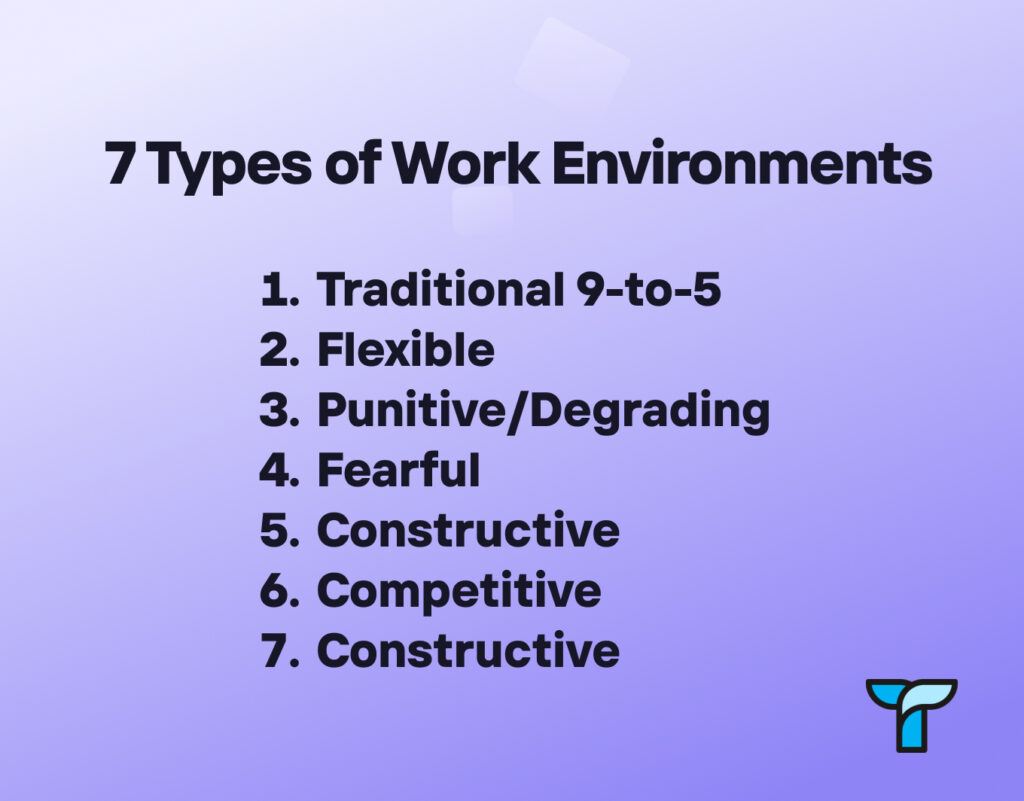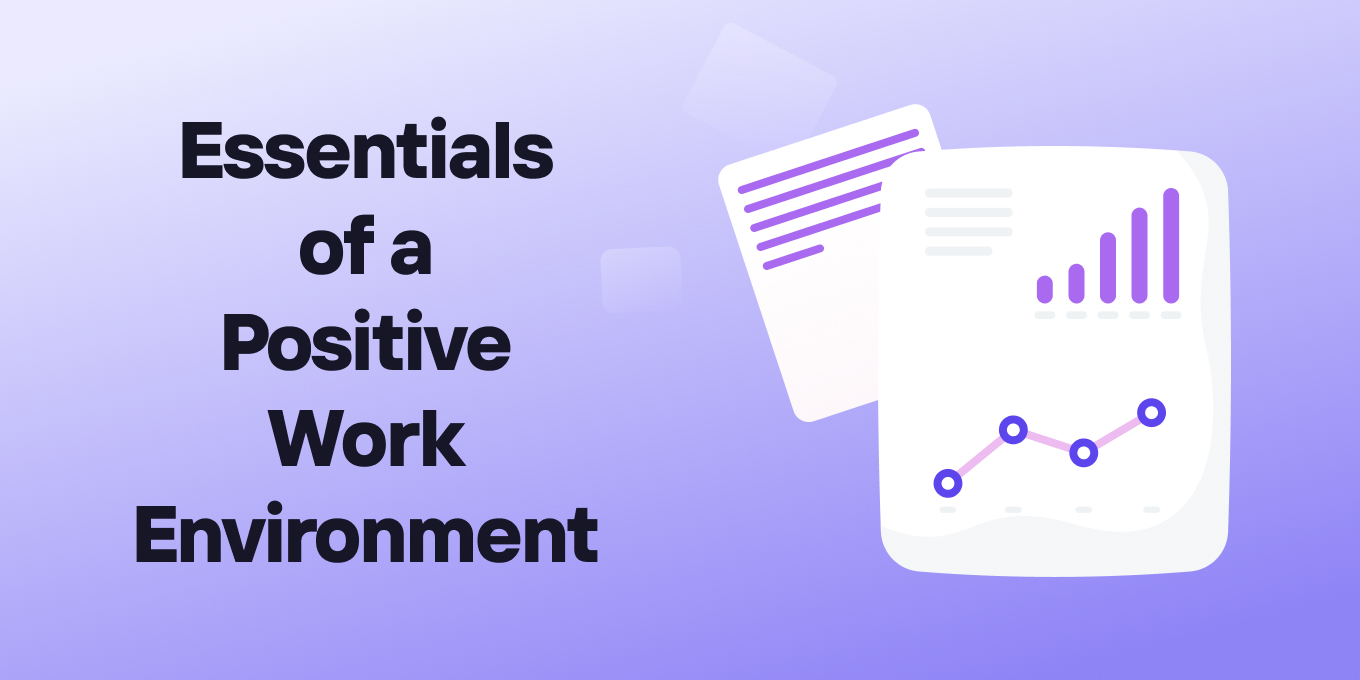A work environment is the collective term for the various conditions or settings that influence an employee’s productivity, satisfaction, and overall well-being at work.
It is a multifaceted concept that includes not just the physical aspects like office layout and amenities, but also intangible elements such as organizational culture, management styles, and social interactions.
A conducive work environment is fundamental to fostering a motivated, productive, and satisfied workforce, which ultimately increases employee productivity.
This environment serves as the backbone of an organization, directly influencing an employee’s performance, motivation, and overall job satisfaction. In other words, it forms the setting in which employees operate, engage, and create value for the organization.
A positive work environment is not merely about having a pleasant office or good pay. It goes deeper into how employees feel about their work, their colleagues, their leaders, and the organization as a whole. It involves fostering an atmosphere of respect, trust, and openness, promoting employee well-being, and enabling opportunities for growth and development.
A conducive work environment plays a pivotal role in driving performance, innovation, and job satisfaction. It can reduce stress and burnout, minimize turnover, and cultivate a sense of belonging among employees. Moreover, a positive work environment can bolster the organization’s reputation, making it a desirable place to work for potential talent.
In an era marked by rapid technological advancements and shifting work dynamics, the importance of a positive work environment cannot be overstated.
Whether it’s an in-house setup, remote work, or a hybrid model, ensuring a conducive work environment is a crucial responsibility for organizations. This post aims to explore the various facets of a work environment, the types of work environments, what employees desire in a workplace, and the characteristics of a positive work environment.
The Key Factors of a Work Environment
Various factors make up a work environment. An exploration of what makes for a positive – or negative – workplace environment starts with defining the key components of the environment itself.
Physical
The physical aspect of a work environment involves much more than merely the workspace layout. It includes the overall ambiance, lighting, temperature, office ergonomics, cleanliness, noise levels, and other factors that directly influence an employee’s comfort, health, and efficiency.
A well-designed physical environment reduces stress and fatigue, promoting better focus and productivity. If the environment has poor lighting, has a lot of distractions, or has poorly regulated temperature then team members are likely to be agitated, stressed, distracted or otherwise unable to do their best work.
Intangibles
Intangible factors are the unseen forces that significantly influence the work atmosphere. These encompass leadership styles, communication patterns, recognition systems, and even the degree of autonomy granted to employees.
For instance, a transparent communication system or a leadership style that encourages participation and empowerment can boost morale and drive engagement. Conversely, a communication style or system that keeps employees in the dark about key business issues is more likely to contribute to a poor work environment.
Culture
Organizational culture refers to the shared values, beliefs, and practices that govern how an organization operates. It determines how employees interact with each other, how decisions are made, and how work is executed. Great culture has these things well-defined and documented so everyone is on the same page.
A positive entrepreneurial culture that values diversity, fosters learning, and rewards effort can significantly enhance the work environment. A culture where actions do not align with company values or beliefs can quickly become toxic.
Pay & Compensation Structure
Compensation is a critical aspect of a work environment. Fair and competitive compensation, encompassing salaries, bonuses, and other benefits, can significantly influence employee motivation, job satisfaction, and retention.
A well-structured compensation plan can signal an organization’s value for its employees, thereby boosting their commitment and performance. If compensation is low or the compensation plan is difficult to understand then employees may feel unmotivated or disinterested in staying with the company long-term.
Social Interactions
Social interactions among employees play a pivotal role in shaping the work environment. Positive and respectful interactions can lead to a more collaborative and harmonious workplace, enhancing job satisfaction, and reducing stress.
Remote, In-House, Hybrid
The mode of operation, whether remote, in-house, or hybrid, also contributes to the work environment. Each model has its unique challenges and advantages that can affect employee productivity, communication, and work-life balance.
Some employees and teams thrive in office environments when working together. Other businesses and employees are more productive when working remote.
Other Conditions That Impact the Work Environment
Work-Life Balance
Work-life balance refers to the equilibrium an employee can maintain between their work demands and personal life. It’s a key determinant of job satisfaction and overall work environment. A positive work environment promotes this balance, leading to healthier, happier, and more productive employees.
Safety
Safety in a work environment is crucial. This includes not just physical safety, but also psychological safety where employees feel respected, valued, and free to express their thoughts and ideas without fear of retribution.

7 Types of Work Environments
The above pillars of a workplace are made real in different ways. While there are always outliers, the seven most common types of work environments are detailed below. If you are evaluating your existing work environment or looking to re-orient what a regular work day looks like, an understanding of these environments is a great place to start. Keep in mind that these environments can exist simultaneously. For example, a traditional 9 to 5 environment can also be constructive just as a flexible work environment can also be competitive.
1. Traditional 9 to 5
This is the classic work environment that follows a strict work schedule, typically from 9 AM to 5 PM, with little to no flexibility. While it offers a clear separation of work and personal life, it may lack the flexibility that many modern employees desire.
2. Flexible (Hybrid, Varied Hours)
A flexible work environment offers more freedom in terms of working hours and location. This could mean offering remote work opportunities, flexible schedules, or a hybrid model combining in-office and remote work. Such an environment is often appreciated for its work-life balance.
3. Punitive/Degrading
In this negative work environment, mistakes are severely punished, and employees may often be belittled or degraded. This can lead to high levels of stress, low morale, and high turnover rates.
4. Fearful
In a fearful work environment, employees are constantly under pressure, often due to high demands, risk of job loss, or toxic management. This type of environment can have detrimental effects on employee mental health and productivity.
5. Constructive
A constructive work environment encourages growth, learning, and development. Feedback is provided in a constructive manner, mistakes are seen as learning opportunities, company information and guidelines are readily available, and employees’ efforts are appreciated and rewarded.
6. Competitive
A competitive work environment, often found in sales-oriented industries or startups, drives employees to outperform each other. While this can foster innovation and high performance, it may also lead to stress if not managed well.
7. Collaborative
A collaborative work environment is characterized by teamwork and cooperation. Employees work together to achieve common goals, and individual achievements contribute to the team’s success. This environment fosters communication, mutual respect, and shared responsibility.
What Work Environments Do Employees Actually Want?
In the evolving landscape of work, employees’ preferences for their work environment are shifting. Today’s employees are not just looking for a good paycheck; they are seeking meaningful work, a positive work culture, work-life balance, opportunities for personal and professional growth, and a sense of being valued and respected.
Let’s delve deeper into these aspects:
- Flexible Work Arrangements: In the wake of the COVID-19 pandemic, the world has seen an unprecedented shift towards remote work. This change has emphasized the importance of flexibility in work arrangements. Employees today value the option to work from home, or follow a hybrid model, which allows a balance between remote and in-office work. Such flexibility can significantly enhance work-life balance and reduce stress.
- Constructive and Collaborative Work Environment: Employees prefer a work environment that encourages learning and growth. They appreciate when their mistakes are treated as learning opportunities rather than failures. Additionally, a workplace that promotes collaboration fosters a sense of community, which can enhance job satisfaction and productivity.
- Culture of Respect and Inclusivity: A workplace that values diversity and fosters an inclusive and respectful environment is highly sought after. Employees want to feel valued and respected for their individuality and contributions, regardless of their background, beliefs, or personal characteristics.
- Transparency and Trust: Employees appreciate a work environment where communication is open and transparent. They want to trust their leaders and feel confident that they are being kept informed about the organization’s plans and decisions. This transparency can foster a sense of belonging and trust in the organization.
- Opportunities for Growth: Employees are more likely to feel satisfied in a work environment that provides opportunities for personal and professional development. They value ongoing learning, mentorship, and the chance to advance in their careers.
- Fair Compensation: While pay is not the only factor that matters, fair and competitive compensation is still important. Employees value a compensation structure that adequately rewards their efforts and reflects the market value of their skills and experience.
- Work-Life Balance: Finally, employees want a work environment that respects their personal lives. This means having time for family, hobbies, rest, and other non-work activities. Overworking can lead to burnout, so a work environment that promotes a healthy work-life balance is highly desirable.
In essence, today’s employees seek a holistic work environment that respects their needs and values their contributions. The modern work environment is not just a place to earn a living, but a space where employees can grow, thrive, and find fulfillment.
Great Businesses Start with Great Work Environments
A positive work environment is a multifaceted concept that requires a thoughtful blend of physical and intangible elements. This includes a comfortable physical workspace, a supportive culture, fair compensation, work-life balance, and opportunities for growth and development.
Trust, cooperation, and collaboration stand as pillars in building this environment.
Recognizing what employees want in a work environment is the first step towards creating a more positive and productive workplace. The shift towards flexible, inclusive, and growth-oriented work cultures is not just a trend, but a reflection of evolving workforce expectations.
To facilitate a positive work environment, it’s essential to have the right tools in place that promote communication, collaboration, and knowledge sharing.
Tettra is one such tool, a knowledge management platform designed to help teams share information, collaborate better, and make quicker decisions.
To learn more about how Tettra can help you foster a positive work environment, start your free knowledge base.


